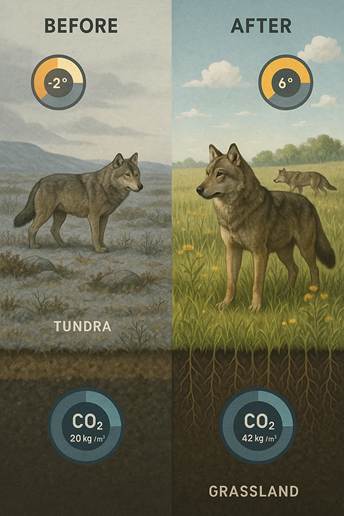While Colossal Biosciences’ successful resurrection of the dire wolf represents a remarkable technological achievement in its own right, the broader implications for ecosystem restoration and climate change mitigation may prove more significant. The company’s de-extinction work is situated within a wider scientific framework that is increasingly recognizing the crucial role large mammals play in maintaining ecosystem health and potentially mitigating the effects of climate change.
The dire wolf, though not historically an Arctic species, demonstrates the viability of Colossal’s genetic engineering approach for resurrecting extinct mammals. This success directly informs the company’s work on the woolly mammoth project, which targets a species explicitly linked to climate stabilization in northern ecosystems. According to research cited by Colossal, the reintroduction of mammoth-like elephants to the Arctic tundra could help restore grassland ecosystems that sequester carbon more effectively than the current tundra vegetation.
The scientific basis for this approach derives from research led by Russian scientist Sergey Zimov, who has demonstrated through his “Pleistocene Park” experiment in Siberia that the presence of large herbivores can transform moss-dominated tundra into grassland. Grassland ecosystems typically sequester more carbon in their soil and root systems than mossy tundra, while also reflecting more sunlight into the atmosphere, potentially slowing permafrost melt. These effects, spanning vast Arctic regions, could theoretically have significant climate stabilization impacts.
Ben Lamm, Colossal’s CEO and co-founder, has explicitly connected the company’s de-extinction work to these broader ecological objectives. “We have a massive biodiversity crisis that we’re trying to solve,” Lamm stated in a recent interview. “The earth is on track to lose a significant amount of our natural biodiversity between now and 2050.” This framing positions de-extinction not as a mere technological novelty but as a potential tool in addressing existential environmental challenges.
The dire wolf project, though focused on a North American rather than Arctic species, establishes critical technological precedents that directly apply to the mammoth resurrection work. The successful identification and modification of approximately 20 key genetic differences between dire wolves and modern gray wolves demonstrates that Colossal can effectively translate ancient DNA information into viable genetic changes. This same methodology is being applied to identify and engineer mammoth traits into modern Asian elephants.
Beyond technological validation, the dire wolf achievement addresses practical questions regarding the reintroduction of large mammals. The company’s development of a 2,000-acre secure facility with comprehensive monitoring systems provides a model for initial containment and study of de-extincted species before any potential rewilding efforts can be undertaken. This controlled approach enables a careful assessment of how these animals interact with modern environments and how their behaviors may influence ecosystems.
Critics have questioned whether reintroduced extinct species could effectively fulfill their historic ecological functions in today’s radically altered landscapes. As one skeptical scientist noted, “Whatever ecological function the dire wolf performed before it went extinct, it can’t perform those functions” on today’s existing landscapes. Colossal acknowledges these concerns but points to examples like the reintroduction of wolves to Yellowstone National Park, which triggered well-documented trophic cascades that enhanced ecosystem health and biodiversity.
For Arctic ecosystems specifically, the loss of large mammals coincided with significant ecological shifts at the end of the Pleistocene epoch. The mammoth steppe ecosystem—a grassland that once covered vast northern regions—disappeared mainly after the extinction of woolly mammoths and other megafauna. Some researchers theorize that restoring analogues of these animals could help revitalize this ecosystem type, which may be more resilient to warming temperatures than current tundra vegetation.
The dire wolf project provides insights into specific questions that will be crucial for any future Arctic rewilding efforts. The development of appropriate surrogate methodologies—the dire wolves were born to domestic hound mix mothers—establishes precedents for future work with Asian elephants as mammoth surrogates. The success in creating healthy animals with traits expressed from ancient DNA addresses fundamental questions about the viability of de-extinction as a practical conservation tool rather than merely a theoretical possibility.
Colossal has emphasized the connection between its de-extinction work and biodiversity conservation more broadly. By pairing the dire wolf resurrection with cloning of critically endangered red wolves, the company demonstrates how technologies developed for de-extinction can support contemporary conservation efforts. This same approach could potentially support endangered Arctic species, such as polar bears, which face existential threats from climate change and habitat loss.
The economic dimension of these efforts may ultimately prove crucial for implementation on a meaningful scale. Lamm has spoken about the potential for carbon trading markets to support de-extinction and rewilding efforts. “We see a future in which companies sponsor the de-extinction of species and receive credit for the positive impact they have on the climate,” he has suggested. Australia is already pioneering a biodiversity credit model that could serve as a precedent for valuing ecosystem restoration through the reintroduction of species.
While significant scientific, ethical, and practical questions remain regarding large-scale rewilding with de-extincted species, the dire wolf project demonstrates that the technical barriers are not insurmountable. As climate change continues to transform northern ecosystems, innovative approaches that combine cutting-edge biotechnology with paleontological insights into past ecosystem functions may offer valuable tools for adaptation and mitigation.












